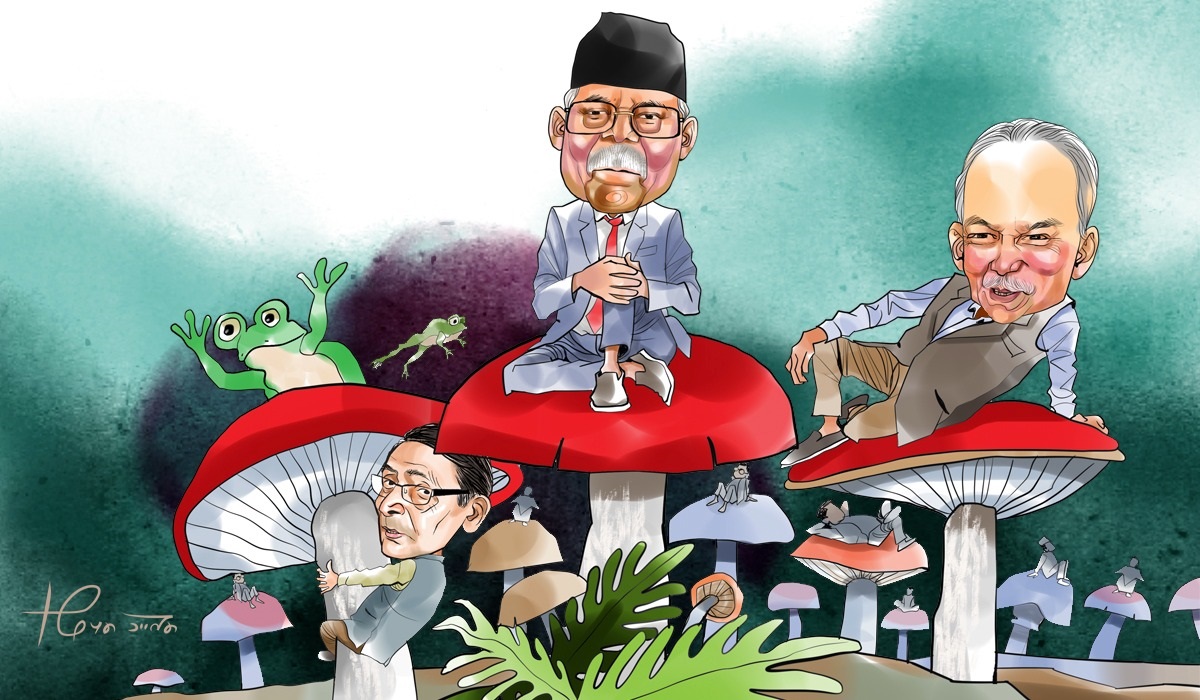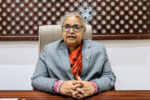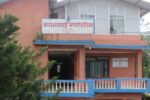KATHMANDU: The Communist Party of Nepal has a history spanning 76 years. Over the course of these decades, the communist movement in Nepal has fractured significantly, with 19 separate communist parties now existing in the country.
For the movement to thrive, unity is essential, yet internal power struggles and leadership conflicts have led to repeated splits.
This phenomenon, particularly within the Maoist faction, continues to undermine the movement’s progress.
The monarchy has fallen, and Nepal has become a republic. However, the promises of people’s rule and social justice—once championed by the Maoists—remain unfulfilled.
The voices of the oppressed and marginalized, which the Maoists fought for, are scarcely heard today.
Despite the political transformation, the people have yet to experience the social justice they were promised.
After abandoning armed conflict and entering peaceful politics in 2063 BS, the Maoists emerged as the leading political force in the 2064 BS elections.
Yet, despite their early success, the Maoists have splintered into 11 different factions over the course of their 18-year history.
Since 2064 BS, Maoist leaders have been appointed to ministerial positions more than 120 times.
However, the number of distinct leaders involved in these appointments is far smaller—only 83 individuals have held these roles.
Typically, in a five-year term, a maximum of three ministers from each party would hold office.
Yet, over the past 15 years, Maoist leaders have held ministerial positions 118 times, indicating a high turnover and frequent reshuffling of power within the party.
Moreover, Maoist leaders have served as prime ministers on four occasions.
Pushpa Kamal Dahal “Prachanda”, in particular, has held the position three times—in 2065, 2073, and 2079 as the Prime Minister.
Dr. Baburam Bhattarai, another prominent Maoist leader, became prime minister in 2068 BS but left the party in Asoj 2072 BS.
Since the 2064 elections, Maoists have been a part of almost every government, with only a few brief exceptions.
Despite this, one pressing question remains: Why do the people continue to suffer under conditions similar to those of previous capitalist governments, even when the party of the proletariat is in power?
The Maoists, despite holding key positions in the government, have failed to enact the changes they promised.
Internal divisions and constant infighting have hindered their ability to strengthen their position and fulfill their vision for Nepal.
Throughout their history, the Maoists have fractured repeatedly, often over trivial issues like leadership disputes—symbolized by the now-infamous “fight over the leader’s mustache.”
This persistent infighting has only deepened the party’s divisions and prevented it from realizing its full potential.
Maoist Center: Pushpa Kamal Dahal “Prachanda”
Nepal Samajwadi Party (Naya Shakti): Dr. Baburam Bhattarai
Nepal Samajwadi Party: Gangalal Shrestha, Mahindra Raya Yadav
CPN: Netra Bikram Chand “Biplav”
Aam Janata Party: Prabhu Sah
Revolutionary Communist Party: Mohan Vaidya
CPN Majority (Bahumat): Hemanta Prakash Wali, Dharmendra Bastola
CPN Maoist: Gopal Kirati
Scientific (Baiganik) Samajwadi Party: Bishwabhakta Dulal
CPN Unified: Chandradev Joshi
Ram Bahadur Thapa Badal group in UML
Maoist Center
The Maoist Center is currently the second-largest party in Nepal’s parliament, holding 32 seats in the House of Representatives.
After the 2079 elections, the party’s chairman, Pushpa Kamal Dahal, became Prime Minister.
However, his tenure was brief, as he was replaced by KP Sharma Oli on Ashad 30.
The Maoist Center was founded in 1994 after separating from the Nepal Communist Party Unity Center.
Since its inception, the party has been led by Chairman Prachanda. In 2052 BS, the party began an armed struggle, which later culminated in the signing of the Comprehensive Peace Accord in 2063 BS.
The Maoists, who became the dominant political force in the 2064 BS elections, have since dwindled to the third-largest force in the country. Over the years, the party has fragmented into 11 factions.
Aam Janata Party
The Aam Janata Party was founded by Prabhu Sah after he joined the UML and then parted ways with the Maoists.
Established on Poush 14, 2079, the party currently holds one seat in the House of Representatives.
While the party is believed to have influence in Madhesh Province, its impact remains uncertain since it has not yet faced a major election.
Additionally, the party has not expanded its organizational presence nationwide.
Nepal Samajwadi Party (Naya Shakti)
Led by Dr. Baburam Bhattarai, the Nepal Samajwadi Party (Naya Shakti) is currently not represented in parliamentary politics.
Bhattarai, who left the Maoists to form Naya Shakti Nepal, did not achieve significant success in the 2079 elections.
He also ceded his constituency to Prachanda. Mahindra Ray Yadav, co-chairman of Naya Shakti Nepal, won from Sarlahi 2 but has since separated from the party.
This split resulted in two factions of the Nepal Samajwadi Party, with the Yadav-led faction in the process of merging with the Maoists.
Nepal Samajwadi Party
Former Maoist leader Gangalal Shrestha, who left the Maoists to join forces with Dr. Bhattarai, along with Madhesh leader Mahindra Ray Yadav, formed a new faction of the Nepal Samajwadi Party after 2079.
Although the party has one seat in the House of Representatives, it is largely part of the Socialist Front.
The NSP is in the process of merging with the Maoists, though no formal merger has occurred yet.
NCP (Revolutionary Maoist)
The NCP, led by Netra Bikram Chand “Biplav,” has yet to enter parliamentary politics.
Biplav formed this party in 2071 after the Nepal Communist Party (Revolutionary Maoist), led by Mohan Baidya, dissolved.
In 2069 BS, Prachanda’s faction also splintered, with some leaders breaking away to form a new party under Baidya’s leadership.
In 2075 BS, Biplav’s group was banned by the government for its involvement in criminal activities and attacks on development infrastructure.
Despite this, Biplav has managed to retain some influence, and leaders from his faction have returned to active politics.
Though Prachanda has attempted to bring Biplav back into his fold, Biplav has maintained his separate stance.
He is a member of the Socialist Front (Samajwadi Morcha), but some theoretical differences continue to complicate any potential unity between the Maoists and Biplav’s faction.
The spokesperson for this party is Khadga Bahadur Bishwakarma.
Revolutionary Communist Party
Mohan Baidya, a long-time Maoist leader, diverged from Prachanda after the peace process. In 2065 BS, Baidya issued a parallel document expressing ideological disagreements with the party.
Prachanda’s decision to align with Ram Bahadur Thapa Badal—now a Vice Chair in the UML—further alienated Baidya, and in 2069 BS, he formed a separate faction.
This split was also marked by the departure of leaders like Biplav, who challenged Prachanda’s leadership.
Despite these divisions, Baidya’s party has managed to remain relevant, though it has never gained widespread national support.
Although there have been occasional discussions about unity with the Maoists, no significant progress has been made.
With Baidya’s health deteriorating, the party’s influence has weakened further. Baidya’s faction is not part of the Socialist Front, and there are no ongoing talks about potential reunification with the Maoists.
CPN Majority (Bahumat)
The CPN Majority was formed in 2079 BS Baisakh by Hemanta Prakash Wali and Dharmendra Bastola.
This faction emerged as a response to dissatisfaction with the Netra Bikram Chand group’s attempts to enter parliamentary politics.
The leader of the disgruntled faction, Dharmendra Bastola, became the coordinator of the party.
At the time of its formation, Prime Minister KP Sharma Oli and Biplav engaged in talks with the group.
CPN Maoist
The CPN Maoist, led by Gopal Kirati, remains largely under the radar. While discussions about a potential unity with the Maoist Center have taken place, no conclusion has been reached.
Kirati is currently leading a campaign to prevent the construction of a cable car system in Pathibhara, eastern Nepal.
After Prachanda formed the CPN in 2074 BS by merging with the UML, Kirati, dissatisfied with the union, left the party.
He then announced the reorganization of the Maoist Center and began a new chapter by registering the CPN Maoist Center with the Election Commission in his own name.
However, after the CPN split and the Maoists returned to their previous state, a legal dispute arose over the party’s name.
Following the court’s ruling in favor of Prachanda’s Maoist party, Kirati renamed his faction the Maoist Communist Party Nepal.
He appointed Ram Narayan Pal as the general secretary to safeguard the party’s legacy.
Despite this, the party remains in the shadows, with Kirati and his associates now more focused on intellectual pursuits than on active political engagement.
Baiganik Samajwadi Party (Scientific Socialist Party)
The Scientific Socialist Party, led by Bishwabhakta Dulal “Ahuti”, was founded around 2076 BS.
Like many smaller parties, it has struggled to expand beyond a limited base. The party was formed by a splinter group from the Revolutionary Communist Party, led by Baidya.
Ahuti has continued to lead the party, which held its first national conference in 2081 BS and its first general conference in 2078 BS.
Despite these efforts, the party has failed to gain significant momentum.
CPN Unified
CPN Unified, revived by Chandradev Joshi in 2076 BS, traces its origins to the earlier unity between the Nepal Communist Party (CPN) and the Maoists.
Following the breakdown of that union, Joshi’s faction revived the CPN Unified, but it remains largely confined to a small, dedicated group.
This party has struggled to expand its influence beyond a limited circle.
Maoist leaders joining CPN-UML
When the Nepal Communist Party split, some leaders, including Ram Bahadur Thapa “Badal”, Top Bahadur Rayamajhi, and Lekhraj Bhatta, chose to remain in the UML.
Badal, a key figure in the “People’s War” and an ideological leader within the party, continued his association with the UML after the 2074 merger between the UML and the Maoists.
However, tensions between UML Chairman Oli and Prachanda soon emerged, leading to the dissolution of the House of Representatives twice.
As the rift deepened, the Maoists and the UML eventually reverted to their previous positions.
Despite this, Badal, a leader closely aligned with Prachanda, remained in the UML and is now serving as its vice president.
Another leader, Top Bahadur Rayamajhi, was once a UML secretary but is currently imprisoned.
While these leaders oppose the Maoists, they have not regained significant influence within the UML and continue to challenge the Maoists from within the party.
Former Maoist factions remain far from unity
None of the former Maoist leaders who split from the mainstream Maoist Center have been successful in gaining significant influence or establishing a strong presence among the people.
Although the parties retain the “Maoist” label, they have struggled to make an impact.
Furthermore, the possibility of unity among these factions seems increasingly unlikely.
There were discussions about the potential for unity between Biplav’s CPN, Gangalal Shrestha and Mahindra Rayee’s party, and Hemanta Prakash Wali and Dharmendra Bastola’s CPN Majority.
However, these discussions have faded over time. Instead, Prachanda’s focus remains on strengthening the Socialist Front.
Prachanda had initially planned to unite the former Maoists ahead of the 2084 elections, but old divisions and leaders have hindered progress.
There seems to be little hope for reconciliation between Prachanda and Baburam Bhattarai.
Meanwhile, Prabhu Sah formed the Aam Janata Party after the 2079 elections, and Baidya’s Revolutionary Communist Party remains unwilling to unite.
Baidya has voiced his dissatisfaction, claiming that the former Maoists have suffered under Prachanda’s leadership.
Similarly, the CPN-Maoist led by Gopal Kirati is also opposed to unity. The Maoists have reached out to Bishwabhakta Dulal’s Scientific Socialist Party, Rishi Kattel’s Nepal Communist Party, and Chandradev Joshi’s CPN (United) to unite, but none of these factions have shown interest.
Maoist Center General Secretary Dev Gurung explained that despite discussions, there has been no concrete progress toward unity.
“The discussions are positive, but nothing substantial has come out of them. Biplav, NSP, and CPN (Maoist) Majority are all in favor of unity, and talks are ongoing,” Gurung told Khabarhub.
“It may not be possible to bring everyone together, as we need to agree on ideas and principles. We are working to strengthen the Maoist movement. Former comrades should join, but only if their presence is necessary.”
Gurung also acknowledged that it is unlikely all 10 parties formed after the Maoist Center split will reunite.
He remains optimistic that some former Maoist factions and leaders will come together by 2084 BS. “Although discussions were held a year ago, progress has been slow,” he said.
NSP leader Gangalal Shrestha also believes that some former Maoist factions and leaders will unite by 2084 BS.
However, he noted that technical matters are still being worked out in the unification process.
Meanwhile, Biplav’s NCP is preparing to enter parliamentary politics by 2084 BS.
Recently, informal and formal discussions have taken place between Biplav and Prachanda about potential unification.
However, they remain uncertain whether to bring the former Maoists together or focus on strengthening the Socialist Front.
Analyst: Unity among former Maoists unlikely
Left-wing analyst Shyam Shrestha argues that there is little chance of all former Maoist parties and leaders coming together.
He believes that even if some factions do unite, the deep divisions—exemplified by the “moustache fight”—will prevent full reconciliation.
“It may not be possible for all to come together, but some may unite,” Shrestha told Khabarhub.
“Even if the ideas, principles, and actions are aligned, the personal conflicts, like the moustache fight, remain a significant barrier.”
He emphasized that the justification for a unified movement should be confirmed through actual unity. “It would be ideal if all communists could unite,” he added.









Comment